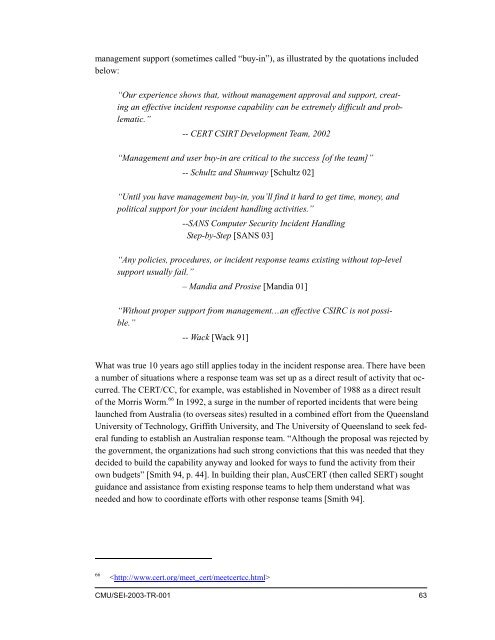State of the Practice of Computer Security Incident Response Teams ...
State of the Practice of Computer Security Incident Response Teams ...
State of the Practice of Computer Security Incident Response Teams ...
You also want an ePaper? Increase the reach of your titles
YUMPU automatically turns print PDFs into web optimized ePapers that Google loves.
management support (sometimes called “buy-in”), as illustrated by <strong>the</strong> quotations included<br />
below:<br />
“Our experience shows that, without management approval and support, creating<br />
an effective incident response capability can be extremely difficult and problematic.”<br />
-- CERT CSIRT Development Team, 2002<br />
“Management and user buy-in are critical to <strong>the</strong> success [<strong>of</strong> <strong>the</strong> team]”<br />
-- Schultz and Shumway [Schultz 02]<br />
“Until you have management buy-in, you’ll find it hard to get time, money, and<br />
political support for your incident handling activities.”<br />
--SANS <strong>Computer</strong> <strong>Security</strong> <strong>Incident</strong> Handling<br />
Step-by-Step [SANS 03]<br />
“Any policies, procedures, or incident response teams existing without top-level<br />
support usually fail.”<br />
– Mandia and Prosise [Mandia 01]<br />
“Without proper support from management…an effective CSIRC is not possible.”<br />
-- Wack [Wack 91]<br />
What was true 10 years ago still applies today in <strong>the</strong> incident response area. There have been<br />
a number <strong>of</strong> situations where a response team was set up as a direct result <strong>of</strong> activity that occurred.<br />
The CERT/CC, for example, was established in November <strong>of</strong> 1988 as a direct result<br />
<strong>of</strong> <strong>the</strong> Morris Worm. 66 In 1992, a surge in <strong>the</strong> number <strong>of</strong> reported incidents that were being<br />
launched from Australia (to overseas sites) resulted in a combined effort from <strong>the</strong> Queensland<br />
University <strong>of</strong> Technology, Griffith University, and The University <strong>of</strong> Queensland to seek federal<br />
funding to establish an Australian response team. “Although <strong>the</strong> proposal was rejected by<br />
<strong>the</strong> government, <strong>the</strong> organizations had such strong convictions that this was needed that <strong>the</strong>y<br />
decided to build <strong>the</strong> capability anyway and looked for ways to fund <strong>the</strong> activity from <strong>the</strong>ir<br />
own budgets” [Smith 94, p. 44]. In building <strong>the</strong>ir plan, AusCERT (<strong>the</strong>n called SERT) sought<br />
guidance and assistance from existing response teams to help <strong>the</strong>m understand what was<br />
needed and how to coordinate efforts with o<strong>the</strong>r response teams [Smith 94].<br />
66<br />
<br />
CMU/SEI-2003-TR-001 63
















